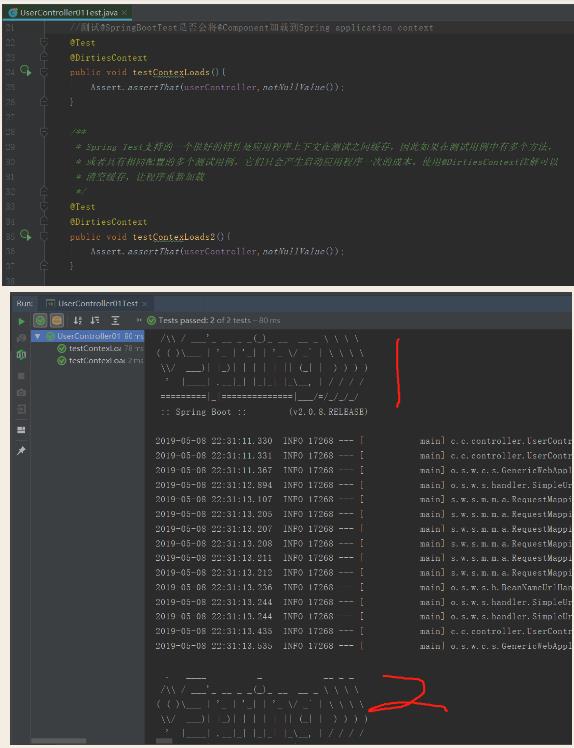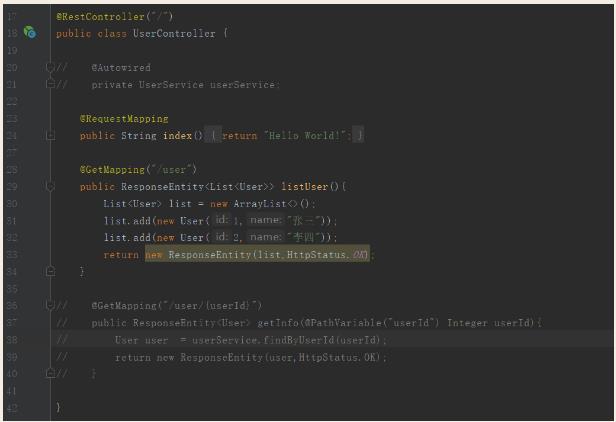SpringBoot测试Controller层
Posted ppjj
tags:
篇首语:本文由小常识网(cha138.com)小编为大家整理,主要介绍了SpringBoot测试Controller层相关的知识,希望对你有一定的参考价值。
一、准备工作
1、导入测试依赖
<dependency>
<groupId>org.springframework.boot</groupId>
<artifactId>spring-boot-starter-test</artifactId>
</dependency>
2、Controller层:
@RestController("/")
public class UserController {
@Autowired
private UserService userService;
@RequestMapping
public String index(){
return "Hello World!";
}
@GetMapping("/user")
public ResponseEntity<List<User>> listUser(){
List<User> list = new ArrayList<>();
list.add(new User(1,"张三"));
list.add(new User(2,"李四"));
return new ResponseEntity(list,HttpStatus.OK);
}
@GetMapping("/user/{userId}")
public ResponseEntity<User> getInfo(@PathVariable("userId") Integer userId){
User user = userService.findByUserId(userId);
return new ResponseEntity(user,HttpStatus.OK);
}
}
3、UserService实现如下:
@Service public class UserServiceImpl implements UserService { @Override public User findByUserId(Integer userId) { return new User(userId,"用户" + userId); } }
二、测试
1、创建第一个测试用例:
在类上添加@RunWith和@SpringBootTest表示是一个可以启动容器的测试类
@RunWith(SpringRunner.class) @SpringBootTest //告诉SpringBoot去寻找主配置类(例如使用@SpringBootApplication注解标注的类),并使用它来启动一个Spring application context;假如不想启动数据库相关的配置和类,可以在使用@SpringBootApplication注解标注的类加上exclude=datasourceautoconfiguration.class,datasourcetransactionmanagerautoconfiguration.class属性 public class UserController01Test { @Autowired private UserController userController; //测试@SpringBootTest是否会将@Component加载到Spring application context @Test public void testContexLoads(){ Assert.assertThat(userController,notNullValue()); } }
2、Spring Test支持的一个很好的特性是应用程序上下文在测试之间缓存,因此如果在测试用例中有多个方法,或者具有相同配置的多个测试用例,它们只会产生启动应用程序一次的成本。使用@DirtiesContext注解可以清空缓存,让程序重新加载。
将上面代码改造如下:在两个方法上都添加@DirtiesContext注解,运行整个测试类,会发现容器加载了两次。

3、启动服务器对Controller进行测试:
这种方式是通过将TestRestTemplate注入进来,进行发送请求测试,缺点是需要启动服务器。
@RunWith(SpringRunner.class) //SpringBootTest.WebEnvironment.RANDOM_PORT设置随机端口启动服务器(有助于避免测试环境中的冲突) @SpringBootTest(webEnvironment = SpringBootTest.WebEnvironment.RANDOM_PORT) public class HttpRequestTest { //使用@LocalServerPort将端口注入进来 @LocalServerPort private int port; @Autowired private TestRestTemplate restTemplate; @Test public void greetingShouldReturnDefaultMessage() throws Exception { Assert.assertThat(this.restTemplate.getForObject("http://localhost:" + port + "/",String.class), Matchers.containsString("Hello World")); } }
4、使用@AutoConfigureMockMvc注解自动注入MockMvc:
@RunWith(SpringRunner.class) @SpringBootTest @AutoConfigureMockMvc //不启动服务器,使用mockMvc进行测试http请求。启动了完整的Spring应用程序上下文,但没有启动服务器 public class UserController02Test { @Autowired private MockMvc mockMvc; /** * .perform() : 执行一个MockMvcRequestBuilders的请求;MockMvcRequestBuilders有.get()、.post()、.put()、.delete()等请求。 * .andDo() : 添加一个MockMvcResultHandlers结果处理器,可以用于打印结果输出(MockMvcResultHandlers.print())。 * .andExpect : 添加MockMvcResultMatchers验证规则,验证执行结果是否正确。 */ @Test public void shouldReturnDefaultMessage() throws Exception { this.mockMvc.perform(get("/")) .andDo(print()) .andExpect(status().isOk()) .andExpect(content().string(containsString("Hello World"))); } }
5、使用@WebMvcTest只初始化Controller层
@RunWith(SpringRunner.class) //使用@WebMvcTest只实例化Web层,而不是整个上下文。在具有多个Controller的应用程序中, // 甚至可以要求仅使用一个实例化,例如@WebMvcTest(UserController.class) @WebMvcTest(UserController.class) public class UserController03Test { @Autowired private MockMvc mockMvc; @Test public void shouldReturnDefaultMessage() throws Exception { this.mockMvc.perform(get("/")) .andDo(print()) .andExpect(status().isOk()) .andExpect(content().string(containsString("Hello World"))); } }
上面的代码会报错,因为我们使用@WebMvcTest只初始化Controller层,但是在UserController 中注入了UserService,所以报错。我们把代码注释如下,该测试就会成功了。

但是一般的Controller成都会引用到Service吧,怎么办呢,我们可以使用mockito框架的@MockBean注解进行模拟,改造后的代码如下:
@RunWith(SpringRunner.class) //使用@WebMvcTest只实例化Web层,而不是整个上下文。在具有多个Controller的应用程序中, // 甚至可以要求仅使用一个实例化,例如@WebMvcTest(UserController.class) @WebMvcTest(UserController.class) public class UserController03Test { @Autowired private MockMvc mockMvc; //模拟出一个userService @MockBean private UserService userService; @Test public void greetingShouldReturnMessageFromService() throws Exception { //模拟userService.findByUserId(1)的行为 when(userService.findByUserId(1)).thenReturn(new User(1,"张三")); String result = this.mockMvc.perform(get("/user/1")) .andDo(print()) .andExpect(status().isOk()) .andExpect(content().contentType(MediaType.APPLICATION_JSON_UTF8)) .andExpect(jsonPath("$.name").value("张三")) .andReturn().getResponse().getContentAsString(); System.out.println("result : " + result); } }
本文转自:https://www.cnblogs.com/caofanqi/p/10836459.html?from=singlemessage
以上是关于SpringBoot测试Controller层的主要内容,如果未能解决你的问题,请参考以下文章